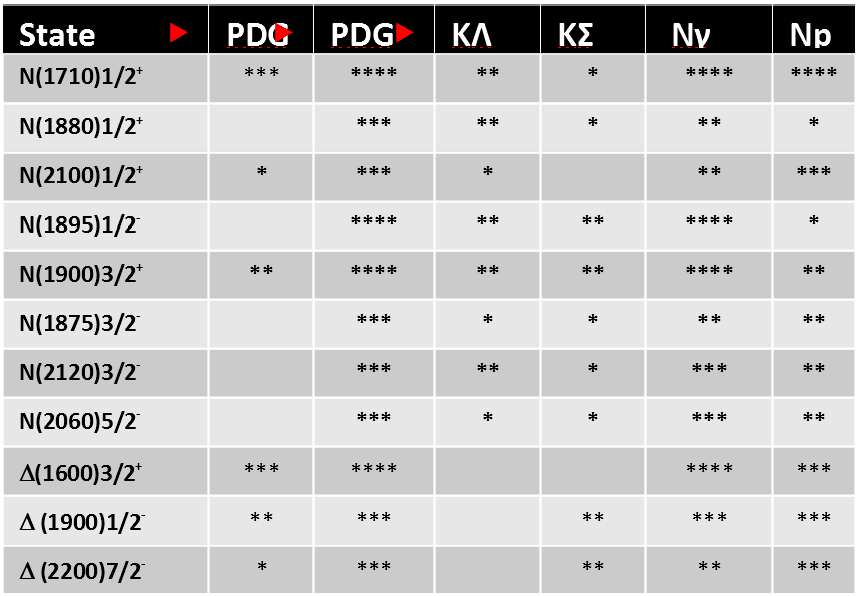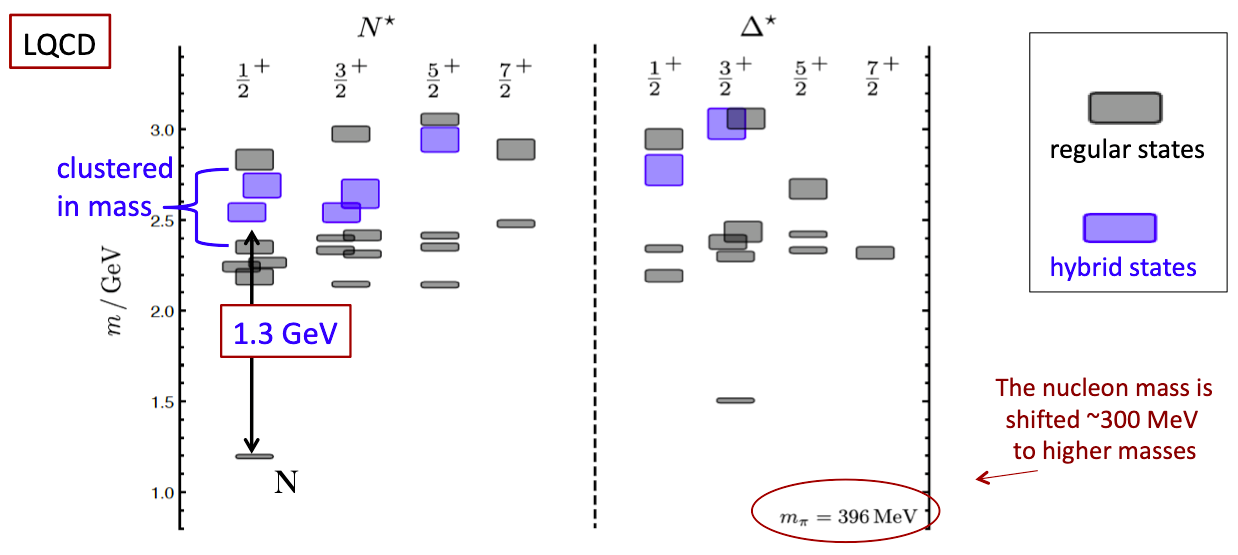Task 4.2: Diffractive and annihilation production and exotic baryon
Coordinator: Annalisa D'Angelo
Contributors: Lucilla Lanza, Bernd Krusche, Alessandra Filippi, Vincent Mathieu
General description:
One of the still open problems in the description of the baryon spectrum by Quark Models or lattice QCD is the missing observation of a sizable number of nucleonic resonances.
Significant progress has been made in recent years and is evident in several new entries of N* and ∆* states in the latest editions of the Review of Particle Properties (PDG), as well as the inclusion of the transition form factor measurement for several excited states.

Figure 1. Recently discovered or upgraded N* and Δ resonances in the mass range 1700-2200 MeV
Most of the newly discovered states have masses in the range 1.85 GeV to 2.1 GeV where precise photoproduction data were driving the new observations, however the mass region above 2.1 GeV has hardly been studied. This is the region where the gluonic excitations are expected to occur, representing the focus of the task in the search of exotic baryons.

Figure 2. Lattice QCD prediction of light baryons spectrum, including states with dominant gluonic degrees of freedom. [ J.J. Dudek and R.G. Edwards, PRD85, 0540(2012)]
The existence of “exotic baryons” whose structure is more complex than a simple three-quarks state not only is compatible with QCD predictions but it has been experimentally observed at LHCb, where evidence of penta-quark states has been obtained [LHCb].
In the search for “missing resonances”, with the scope of a better understanding the nucleon dynamics, new important information can be provided by precision electromagnetic machines operating polarized beams.
The availability of polarized photon beams impinging on polarized targets provide access to single and double polarization observables of meson photo-production processes, which strongly constrain the reaction amplitudes and proved to be the new key information in the discovery of the new resonances, reported in Table 1.
Electro-production of the same mesons-baryon final states produced in photo-reactions allows for the extraction of the resonance electro-couplings and the study of their evolution as a function of the Q2 photon virtuality. This additional information allows to picture the evolution of the effective-degrees N* freedom as a function of the distance scale and to assess the possible hybrid nature of new resonances.
Progress [1-18 months]:
Activity Report: June 2019 – October 2020
The combined analysis of photo-induced and electron-induced meson production has proved to be an effective strategy to exploit the discovery potential of electromagnetic machines operating polarized beams.
Photo-induced mesons production.
In the past decade CLAS at CEBAF run dedicated data takings with circularly polarized photon beams, of energy up to 5 GeV, on longitudinally polarized targets. These data are fundamental to study the trend of single- and double-polarization observables as a function of the available energy W and the angles of the emitted products: such observables provide alternative tools, complementary to PWA, to resolve and characterize possible baryonic missing states. Several final states with particles of different flavor content can be analyzed to extract information on the couplings of the new baryonic resonances and their dependence on flavors. For instance, studies were carried on to extract the E beam-target helicity asymmetry in the γ→ n→ → K+ Σ- reaction on a HD target [Za20]: the trend of this variable cannot be easily reproduced in the framework of QCD quark models without additional hypotheses on the interference patterns and on the couplings between the photon and the known low-mass baryonic resonances, as well as the inclusion of at least one new resonant state.
The same HD target, with different degrees of longitudinal polarization, is used to extract the single- and double-polarization asymmetries for the γ→ n→ → π+ π- N reactions, both on protons and neutrons. This analysis is still in progress: preliminary results shows a good agreement for the trend of the I⊙ beam asymmetry for reactions on both protons and neutrons, as a function of the π+ helicity angle and invariant energy W; the parity-odd expected trend, with some modulations, is followed in every step of W in the range 1.6-2.2 GeV. From the fit of this distribution the relative weight of the J=½ and 3/2 amplitudes can be inferred. The concurrent extraction of the P and Pz⊙ polarization asymmetries is currently underway.
Electro-induced mesons production.
Data taking with polarized electron beams at 6.5 GeV and 7.5 GeV energies on unpolarized proton target occurred at the CLAS12 upgraded facility at CEBAF in December 2018. Data have been calibrated and reconstructed. Kinematical coverage of available data spans in the 0.05 - 4.0 GeV2 range in Q2 and in the 0.95‑3GeV range in W, covering all the invariant phase-space of interest for the study of baryons resonance structure.
Data analysis of e→ p → e K+ Y and e→ p → e π+ π- p reaction channels is underway with the aim of measuring un-separated cross sections and polarization observables with final statistics which surpasses the world database by one order of magnitude.
Data Analysis and Interpretation
Waiting for the first CLAS12 experiments to provide high-precision data on inclusive electron scattering observables the modeling of the resonant contributions to the inclusive electron scattering observables has been published [Hi19]. As input, the existing CLAS electro-coupling results obtained from exclusive meson electro-production data off protons have been used to evaluate for the first time the resonant contributions based on the experimental results on the nucleon resonance electro-excitation. The uncertainties are given by the data and duly propagated through a Monte Carlo approach. In this way, estimates for the resonant contributions have been obtained, important for insight into the nucleon parton distributions in the resonance region and for the studies of quark-hadron duality.
The properties of the hidden-charm pentaquark-like resonances first observed by the LHCb Collaboration in 2015, have been studied estimating the sensitivity of the polarization transfer KLL to the pentaquark photocouplings and hadronic branching ratios. Predictions to the case of the initial-state helicity correlation ALL, using a polarized target have been deduced. These results serve as a benchmark for the SBS experiment at Jefferson Lab, which proposes to measure for the first time the helicity correlations ALL and KLL in J/ψ exclusive photoproduction, in order to determine the pentaquark photocouplings and branching ratios [Wi19].
Finally the nature of the new signal reported by LHCb in the J/ψp spectrum has been studied using a minimum-bias analysis of the underlying reaction amplitude, based on the S-matrix principles and focusing on the analytic properties that can be related to the microscopic origin of the Pc(4312)+ peak. By exploring several amplitude parametrizations, evidence for the attractive effect of the Σ+c¯D0 channel has been found, which is not strong enough, however, to form a bound state [Fe19].
References:
- [Za20] CLAS Collaboration, N. Zachariou et al., Phys. Lett. B880 (2020), 135662
- [Hi19] A. N. Hiller Blin et al. Phys. Rev. C 100 (2019), 035201
- [Wi19] (Joint Physics Analysis Center) D. Winney, et al. Phys. Rev. D 100 (2019), 034019 (2019)
- [Fe19] (Joint Physics Analysis Center) C. Fernández-Ramírez, et al. Phys. Rev. Lett. 123, (2019) 092001
- [LHCb] R. Aaig. et at (LHCb collaboration), Phys. Rev. Lett. 115 (2015) 072001.
